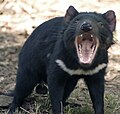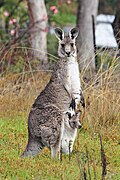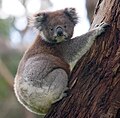AY Honors/Marsupials/Answer Key
1. Distinguish:
a. Mammal from other animals.
The mammals are the class of vertebrate animals characterized by the presence of mammary glands, which in females produce milk for the nourishment of young.
b. Placentals, marsupials and monotremes from one another.
- Placentals
- The placentals are distinguished from other mammals in that the fetus is nourished during pregnancy via a placenta.
- Marsupials
- Marsupials are mammals in which the female typically has a pouch (called the marsupium) in which it rears its young through early infancy. They differ from placental mammals in their reproductive traits.
- Monotremes
- Monotremes are mammals that lay eggs instead of giving birth to live young like marsupials and placental mammals.
2. Understand how marsupials are classified into families and describe, in a general way, the habits of these families.
Omnivorous Marsupials
Opossums are nocturnal marsupials found in the Western Hemisphere. They are small to medium-sized creatures, about the size of a large house cat. Although there are many exceptions, most of them spend time living both in trees and on the ground, and they eat many different things (plants and animals).
Opossums are usually nomadic, staying in one area as long as food and water are easily available. Though they will temporarily occupy abandoned burrows, they do not dig or put much effort into building their own. They favor dark, secure areas, below ground or above.
When threatened or harmed, they will "play possum", mimicking the appearance and smell of a sick or dead animal. The lips are drawn back, teeth are bared, saliva foams around the mouth, and a foul-smelling fluid is secreted from glands. This response is involuntary, rather than a conscious act. Their stiff, curled form can be prodded, turned over, and even carried away. Many injured opossums have been killed by well-meaning people who find a catatonic animal and assume the worst. If you find an injured or apparently dead opossum, the best thing to do is leave it in a quiet place with a clear exit path. In minutes or hours, the animal will regain consciousness and escape quietly on its own.
Shrew opossums (also known as rat opossums) are about the size of a small rat (9–14 cm long), with thin limbs, a long, pointed snout and a slender, hairy tail. They are largely meat-eaters, being active hunters of insects, earthworms and small vertebrates. They have small eyes and poor sight, and hunt in the early evening and at night, using their hearing and long, sensitive whiskers to locate prey. They seem to spend much of their lives in underground burrows and on surface runways.
Largely because of their rugged, inaccessible habitat, they are very poorly known and have traditionally been considered rare. Recent studies suggest that they may be more common than had been thought.
Carnivorous Marsupials
- Numbat at Perth Zoo.jpg
Numbat
This category of marsupials includes the Tasmanian Devil, Numbat, Dunnart, and Quoll. Unlike herbivores, which tend to become highly specialized for particular ecological niches and diversify greatly in form, carnivores tend to be broadly similar to one another, certainly on the level of gross external form. Just as northern hemisphere carnivores like cats, foxes and weasels are much more alike in structure than, for example, camels, goats, pigs and giraffes, so too are the marsupial predators constrained to retain general-purpose, look-alike forms—forms which mirror those of placental carnivores.
Herbivorous Marsupials
This family includes kangaroos, wallabies, wombats, possums (not opossums!) and koalas. For the most part, these animals are found wild only in Australasia.
Kangaroos
There are three species of kangaroo:
- The'Red Kangaroo (Macropus rufus) is the largest surviving marsupial anywhere in the world. Fewer in numbers, the Red Kangaroos occupy the arid and semi-arid centre of the continent. A large male can be 2 metres (6 ft 7 in) tall and weigh 90 kg (200 lb).
- The Eastern Grey Kangaroo (Macropus giganteus) is less well-known than the red (outside of Australia), but the most often seen, as its range covers the fertile eastern part of the continent.
- The Western Grey Kangaroo (Macropus fuliginosus) is slightly smaller again at about 54 kg (119 lb) for a large male. It is found in the southern part of Western Australia, South Australia near the coast, and the Darling River basin.
Wallabies
Essentially, a wallaby is any macropod that isn't large enough to be considered a kangaroo and has not been given some other name. There is no fixed dividing line. In general, a wallaby is smaller and has a stockier build than a kangaroo; a wallaroo is any of a few species somewhat intermediate in size between a wallaby and a kangaroo.
Possums
Possums are small marsupials with brown or grey fur, ranging in size from the length of a finger (pygmy possums and wrist-winged gliders), to the length of a forearm (brushtails and ringtails). All possums are nocturnal and omnivorous, hiding in a nest in a hollow tree during the day and coming out during the night to forage for food. They fill much the same role in the Australian ecosystem that squirrels fill in the northern hemisphere and are broadly similar in appearance.
The two most common species of possums, the Common Brushtail and Common Ringtail, are also among the largest.
Koalas
The Koala is broadly similar in appearance to the wombat, but has a thicker, more luxurious coat, much larger ears, and longer limbs, which are equipped with large, sharp claws to assist with climbing. Weight varies from about 14 kg for a large, southern male, to about 5 kg for a small northern female. Contrary to popular belief, their fur is thick, not soft and cuddly. Koalas' five fingers per paw are arranged with the first two as opposable thumbs, providing better gripping ability.
3. Describe the distribution, habitat (ie. type of country they live in), diet breeding behavior, as well as any other interesting information of twelve different groups of marsupials and monotremes.
4. Be able to explain the difference between marsupial reproduction and that in true mammals (ie. placentals).
The pregnant female marsupial develops a kind of yolk sack in her womb which delivers nutrients to the embryo. The embryo is born at a very early stage of development (at about 4-5 weeks), upon which it crawls up its mother's belly and attaches itself to a nipple (which is located inside the pouch). It remains attached to the nipple for a number of weeks. The offspring later passes through a stage where it temporarily leaves the pouch, returning for warmth and nourishment.
The placenta is a temporary organ composed of two parts, one of which is part of the fetus, the other part of the mother. It is implanted in the wall of the uterus, where it receives nutrients and oxygen from the mother's blood and passes out waste. This interface forms a barrier, the placental barrier, which filters out some substances which could harm the fetus.








